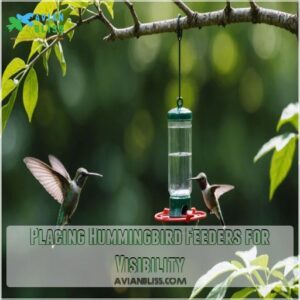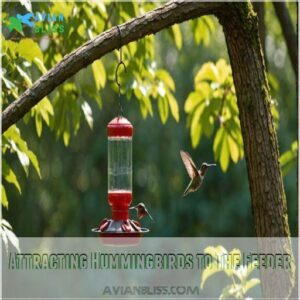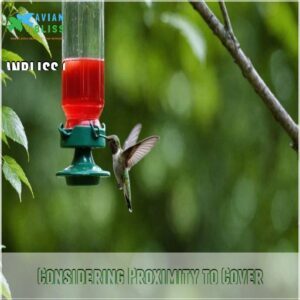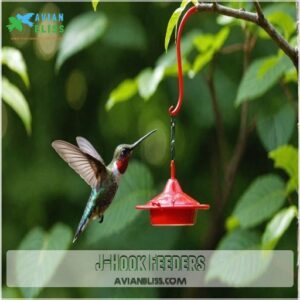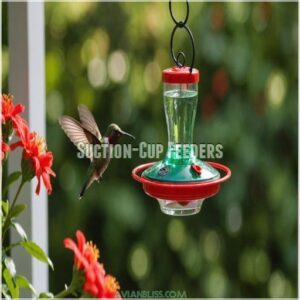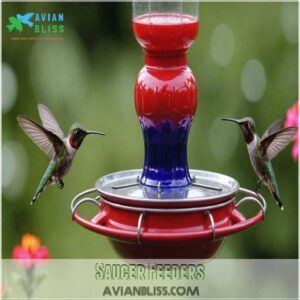This site is supported by our readers. We may earn a commission, at no cost to you, if you purchase through links.
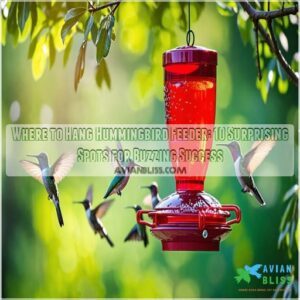 Wondering where to hang your hummingbird feeder for the best feathered traffic?
Wondering where to hang your hummingbird feeder for the best feathered traffic?
Place it in a sunny, open spot near trees or shrubs.
These little buzzers love a good perch, and natural cover offers them safety.
Avoid hanging it too close to windows to prevent collisions.
Use a vividly colored feeder, like red, to catch their attention—think of it as a neon sign for nectar!
You might even add a dash of whimsy with red ribbons or flags nearby.
Keep feeding spots visible and you’ll host a bustling avian party.
Curious about more creative spots? You’re on the right path to discovery!
Table Of Contents
- Key Takeaways
- Choosing The Perfect Location
- Placing Hummingbird Feeders for Visibility
- Protecting Hummingbirds From Elements and Predators
- Attracting Hummingbirds to The Feeder
- Feeder Placement for Convenience
- Considering Proximity to Cover
- Placement Considerations for Safety
- Understanding Hummingbird Behavior
- Hummingbird Feeder Types and Designs
- Maintenance and Upkeep of Hummingbird Feeders
- Frequently Asked Questions (FAQs)
- Should you hang a hummingbird feeder in a sunny spot?
- Where should hummingbird feeders be placed?
- How do you keep hummingbirds in a bird feeder?
- Where should you hang a bird feeder?
- How far apart should hummingbird feeders be hung?
- How close should hummingbird feeders be to bushes?
- Should a hummingbird feeder be in the sun or shade?
- Where is the best location to hang a hummingbird feeder?
- Should hummingbird feeders be hung high or low?
- How do you attract hummingbirds to a new feeder?
- Whats the best time of year to hang a feeder?
- How does feeder color impact hummingbird attraction?
- Can weather conditions affect feeder placement?
- Does feeder material influence hummingbird visits?
- Should feeders be relocated during seasonal changes?
- Conclusion
Key Takeaways
- Hang your hummingbird feeder near nectar-rich blooms, such as native plants like sage and penstemon for natural nectar sources like timing hummingbird feeders, in morning sunlight and afternoon shade to maintain nectar freshness and visibility, attracting more birds.
- Position the feeder 10-15 feet from bushes or trees, providing perching spots and a safe escape route for hummingbirds.
- Keep feeders elevated to protect from predators while ensuring easy access for refills and cleaning, maintaining both safety and convenience.
- Use red feeders or add red accents nearby to catch hummingbirds’ attention, enhancing their attraction to the available nectar.
Choosing The Perfect Location
You’ll need to think like a hummingbird to choose the perfect spot for your feeder.
Consider factors like sun exposure, shade, and clear flight paths to create an irresistible dining area for these tiny, energetic visitors.
Consider Sun Exposure
To attract hummingbirds and minimize visits from unwanted insects like bees at hummingbird feeders, consider the surroundings and potential competition for nectar. The golden rule of hummingbird feeder placement: mind the sun!
You’ll want to find that sweet spot where your feeder catches some rays without turning into a nectar sauna.
Early morning sun is great, but avoid the afternoon heat that can lead to nectar spoilage.
Think about the sun’s angle throughout the day and how it affects your backyard birding setup.
Your tiny visitors will appreciate a perfectly positioned pit stop!
Select a Shaded Area
Under the cool canopy of shade, your hummingbird feeder will thrive.
Shaded spots keep nectar fresh longer, preventing spoilage that can harm these tiny visitors.
You’ll want to hang your feeder where it catches morning rays but escapes the scorching afternoon sun.
This temperature control trick helps your hummingbird garden remain a safe haven.
By strategically placing feeders in shaded areas, you’re not just offering nectar – you’re creating a comfortable oasis for hummingbirds to sip and socialize.
Avoid Obstructions
Clear skies ahead for your hummingbird feeder.
You’ll want to steer clear of obstacles that might cramp these tiny flyers‘ style.
Imagine you’re a hummingbird zipping through the air—you’d want a clear flight path, right?
Opt for a spot with dappled shade benefits.
Here’s your game plan:
- Trim back dense foliage that blocks access
- Avoid hanging near tree branches that sway in the wind
- Steer clear of roof overhangs and building corners
- To minimize encounters with unwanted insects, consider relocating feeders away from flowering plants as recommended for strategically placing hummingbird feeders. Keep feeders away from power lines for safety
This open setup makes sure your feathered friends can buzz in for a sip without any aerial acrobatics.
Placing Hummingbird Feeders for Visibility
You’ll want to place your hummingbird feeder where it catches some light and stays visible to both you and the birds.
Hang it near a window, in a partially sunlit area with enough open space, so you can enjoy watching these tiny acrobats perform their aerial feats.
Hang Feeders Near Windows
Positioning your hummingbird feeder near windows offers a front-row seat to nature’s aerial acrobats. By choosing a spot with partial shade, like under a tree or near a shaded area, you can deter bees who prefer sunny spots, as discussed in how to keep bees away.
You’ll want to strike a balance between visibility and safety.
Here’s a quick guide to help you set up the perfect window-side buffet:
| Feeder Placement | Viewing Experience | Collision Risk |
|---|---|---|
| 0-3 feet | Excellent | Low |
| 3-10 feet | Good | High |
| 10-30 feet | Fair | Low |
| 30+ feet | Poor | Very Low |
| Window Decals | Enhances Safety | Reduces Risk |
Remember, closer isn’t always better.
Aim for either very close or far enough to prevent bird collisions.
Choose Partially Sunlit Areas
While window-watching is a treat, don’t forget the sun’s role in feeder visibility.
You’ll want to find that sweet spot where light meets shade.
Here’s why partial sunlight is key:
- Catches hummingbirds’ eyes with sparkles and reflections
- Prevents nectar spoilage from excessive heat
- Mimics natural feeding spots in dappled forest light
- Creates a warm, inviting area for hummingbirds to linger
- Allows for better viewing as birds hover in sun rays
This balance keeps your hummingbird-friendly yard buzzing with activity all day long.
Ensure Adequate Space
Now that you’ve found your sunny spot, let’s talk elbow room.
Your hummingbird feeding station needs space to shine.
Think of it as a tiny airport – you wouldn’t want planes bumping wings, right?
Hang feeders at least 4 feet apart to prevent territorial squabbles.
This safe distance keeps the peace and allows multiple hummers to dine comfortably.
Plus, it gives you a front-row seat to watch these aerial acrobats zoom in for a snack without any mid-air collisions!
Protecting Hummingbirds From Elements and Predators
You’ll want to shield your hummingbird feeder from harsh weather, such as freezing temperatures, by learning how to keep hummingbird feeders from freezing, and hungry predators to keep your tiny visitors safe and happy.
Hang it in a sheltered spot away from busy areas, and make sure it’s high enough to discourage unwanted guests while still being accessible for refills and cleaning.
Shelter From Wind and Rain
Your tiny feathered friends need a cozy spot to sip their nectar, safe from Mother Nature’s mood swings.
To create a weather-proof dining area, consider these shelter strategies:
- Hang windproof feeders under eaves or awnings
- Use rain-resistant designs with built-in covers
- Place feeders near dense shrubs for natural shelter
By choosing the right spot, you’ll make sure your hummingbird food stays fresh and your outdoor space becomes a haven.
Remember, a stable feeder in a protected area means happy hummers, even when the weather’s less than perfect.
Avoid High-Traffic Areas
Everyone wants to see hummingbirds up close, but placing feeders in busy areas can stress these tiny flyers.
Hang your feeder away from high-traffic spots to create a safe haven.
This reduces disturbances and lets hummers feed in peace.
Here’s a quick guide to help you choose the perfect spot:
| Location | Traffic Level | Suitability |
|---|---|---|
| Near patio | High | Avoid |
| Quiet corner | Low | Ideal |
| By walkway | Medium | Consider carefully |
| Garden edge | Low-Medium | Good option |
Remember, a calm feeding zone means more buzzing visitors!
Hang Feeders High Enough
Gravity-defying acrobats deserve a safe haven. Hang your hummingbird feeder at least 5 feet high to keep these tiny dynamos out of harm’s way.
This height provides predator protection, especially from sneaky cats. For easy access without compromising safety, use a pulley system or extendable pole.
Place the feeder near windows for birdwatching bliss, but not so close it risks window collisions.
Remember, a stable perch equals happy hummers, so secure that nectar buffet tightly!
Attracting Hummingbirds to The Feeder
You’ll attract more hummingbirds to your feeder by using red colors, providing multiple nectar sources, and maintaining your feeders regularly.
Red colors will attract hummingbirds to your feeder.
Providing multiple nectar sources will help attract more hummingbirds.
Maintaining your feeders regularly will also help attract hummingbirds.
By following these simple steps, you’ll create a hummingbird haven that’ll have these tiny acrobats buzzing with delight in no time.
Use Red Feeders
Red feeders are like a hummingbird’s version of a neon "Open" sign.
These tiny dynamos can spot red from a mile away, thanks to their incredible color vision.
To turn your yard into a hummingbird hotspot:
- Hang red feeders in strategic locations
- Use red accents near clear feeders
- Plant red flowers as natural attractants
Remember, it’s not just about the color. Keep your feeders clean and filled with fresh nectar. You’ll be the talk of the hummingbird town in no time!
Provide Nectar Sources
While red feeders catch a hummingbird’s eye, nectar-rich blooms are nature’s buffet.
To complete your hummingbird haven, consider supplementing with nectar-filled flowers, which can be found at stores that sell hummingbird feeder flowers.
Plant these sugar-packed flowers strategically around your feeder to create a hummingbird haven.
Here’s a quick guide to get you started:
| Flower | Bloom Time |
|---|---|
| Trumpet Honeysuckle | Spring-Fall |
| Bee Balm | Summer |
| Cardinal Flower | Late Summer |
| Fuchsia | Spring-Fall |
| Columbine | Spring-Early Summer |
Mix these with your existing garden design for a vibrant, bird-friendly landscape that’ll have hummingbirds buzzing with joy all season long.
Maintain Feeders Regularly
Fresh nectar‘s the key to keeping hummers buzzing back.
You’ll want to stick to a cleaning schedule that’s as regular as clockwork, especially during hot weather when feeders may need cleaning every 2-3 days to prevent nectar spoilage.
Every 3-5 days, give that hummingbird feeder a good scrub to prevent mold and keep ants at bay, following a cleaning routine that includes cleaning hummingbird feeders.
Rinse with hot water, and voilà! Your feeder’s ready for a sugar water refill.
Remember, a clean feeder extends its lifespan and keeps those wild birds healthy and happy.
It’s like rolling out the red carpet for your tiny, feathered friends!
Feeder Placement for Convenience
You’ll want to hang your hummingbird feeder where you can easily reach it for refills and cleaning.
Place it near a deck, patio, or garden path, and you’ll save yourself from awkward stretches or risky ladder climbs while tending to your tiny, feathered friends.
Choose Easily Accessible Locations
Now that you’ve attracted those tiny aerial acrobats, let’s make your life easier.
Choose spots that don’t require a ladder expedition every time you need to refill or clean your hummingbird feeder, and consider using a sturdy hummingbird feeder hook to support it.
Here are some handy locations:
- Just off your deck railing
- Near a frequently used garden path
- Close to your kitchen window
These spots offer easy access for maintenance while keeping the feeders at a safe height. You’ll spend less time wrestling with hard-to-reach feeders and more time enjoying the buzz of hummingbird wings.
Use Binoculars or a Camera
You’ve placed your feeder in an easy-to-reach spot, but let’s zoom in on the action.
Grab your binoculars or camera to get a front-row seat to the hummingbird show.
With a good pair of binoculars, you’ll see their iridescent feathers shimmer like living jewels.
For the shutterbugs, a telephoto lens will capture their lightning-fast wing beats.
It’s like having your own National Geographic special right in your backyard!
Consider Window Feeders
Window feeders bring the buzzing action right to your fingertips.
They’re a game-changer for up-close viewing and easy maintenance.
Here’s why they’re worth considering:
- Unbeatable views: Watch hummingbirds’ iridescent feathers shimmer inches away.
- Safety first: Proper placement reduces collision risks.
- Effortless upkeep: Clean and refill without breaking a sweat.
Pair your window feeder with decorative decals to prevent bird strikes and add a splash of garden accent.
It’s a win-win for both you and your tiny, feathered friends in hummingbird conservation.
Considering Proximity to Cover
You’ll want to hang your hummingbird feeder near protective cover to make these tiny flyers feel safe and secure.
Placing the feeder within 10-15 feet of trees, shrubs, or other natural shelter gives hummingbirds a quick escape route and a cozy spot to rest between sips.
Hang Feeders Near Protective Cover
Hummingbirds are tiny daredevils, but they need a safety net too.
Place your feeder near bushes or trees, giving these little acrobats a quick escape route.
Think of it as their personal superhero hideout!
Aim for spots within 10-15 feet of natural cover.
This clever setup offers predator protection while keeping the feeding station visible.
It’s like creating a cozy, all-you-can-eat buffet with a built-in panic room.
Your feathered friends will thank you for the peace of mind!
Create a Waiting Area
Nearby protective cover isn’t just for hiding; it’s also a cozy waiting room for hummingbirds.
Set up perching spots near your feeder to create a VIP lounge for these tiny guests.
They’ll feel safe and comfortable, keeping an eye on their surroundings while waiting for their turn at the nectar bar.
Here’s how to craft the perfect hummingbird hangout:
- Plant native shrubs or trees within 10-15 feet
- Install thin, horizontal branches as perches
- Add decorative garden stakes for resting spots
- Incorporate flowering vines on trellises or fences
Allow for Quick Escape
While creating a cozy waiting area is great, don’t forget about the quick getaway!
Your little feathered friends need an escape plan.
Hang your feeder near bushes or trees, giving them a safe retreat if danger swoops in.
Think of it as their personal safety net.
By providing nearby cover, you’re offering predator protection and peace of mind.
It’s like giving them a superhero cape – they’ll feel invincible as they zip to safety in the blink of an eye.
Placement Considerations for Safety
You’ll need to pay attention to safety when hanging your hummingbird feeder to protect these tiny visitors.
Place it away from windows to prevent collisions.
In a shaded spot to avoid nectar spoilage.
And securely fastened to guarantee stability during windy days.
Avoid Window Collisions
To avoid window collisions, place your feeder either within 3 feet of windows or more than 30 feet away.
This strategy prevents hummingbirds from building up enough speed to hurt themselves.
Try using window decals or reflective tape to make glass more visible.
Alternatively, opt for window-mounted feeders, which encourage slower approaches.
Remember, these tiny dynamos can’t always hit the brakes in time, so your thoughtful placement can make all the difference in keeping them safe and buzzing.
Prevent Spoilage
Preventing nectar spoilage is just as important as avoiding window collisions.
To keep your sugar water fresh and your tiny friends healthy, follow these simple steps:
- Hang your feeder in a shady spot to slow fermentation.
- Place it where it can get morning sunshine benefits, such as east or west-facing spots.
- Replace nectar every 3-5 days, or sooner if it looks cloudy.
- Clean the feeder thoroughly with each refill.
Remember, spoiled nectar can harm hummingbirds.
By maintaining nectar freshness and cleaning frequency, you’ll create a safe haven for these buzzing beauties. It’s like running a five-star restaurant for nature’s tiniest diners!
Ensure Stability
You’ve got your feeder filled and placed, but let’s make sure it stays put.
Choose sturdy hooks, such as the ones found in hummingbird feeder hooks, for secure mounting.
Strong feeder hooks can make all the difference in withstanding the elements.
Wind resistance is key – you don’t want your feeder swinging like a pendulum in a breeze.
Opt for sheltered spots that offer protection from gusts.
Remember, a wobbling feeder isn’t just annoying; it can deter hummingbirds.
By ensuring stability, you’re creating a safe haven that’ll keep these tiny dynamos coming back for more.
Understanding Hummingbird Behavior
To successfully attract hummingbirds, you need to understand their intriguing behaviors like migration patterns and feeding habits.
Knowing these factors can help you choose the perfect feeder spot where hummingbirds will feel at home, all while they show off their aerial acrobatics.
Hummingbird Migration Patterns
Imagine setting your feeder just right and watching hummingbirds begin their epic migration routes.
Timing is key—knowing when these tiny travelers start their journey can make all the difference.
Various factors like weather and daylight length affect their timing, posing challenges along the way.
Their ultimate destinations often span vast regions, so placing your feeder strategically can help them refuel and continue their adventure safely.
Hummingbird Feeding Habits
Just as hummingbirds migrate with precision, understanding their feeding habits can make feeder placement a breeze.
Nectar preferences play a big role, and you’ll want to cater to their love for sweet treats.
Keep an eye on:
- Feeding frequency: They eat often, so keep the nectar fresh.
- Territorial behavior: Space feeders to avoid battles.
- Perching habits: Offer spots to rest nearby.
- Social interactions: Watch them chatter and flutter!
Hummingbird Social Structure
Consider how fascinating it’s that hummingbirds approach feeding with determined gusto, then pivot to their intricate social life.
These tiny flyers display remarkable territoriality, guarding feeders with surprising aggression at times, which can escalate into physical fights over nectar sources.
During courtship, their aerial dance is a spectacle.
Despite their feisty nature, nesting involves carefully selecting spots, ensuring safety.
Migration, a feat of endurance, takes them thousands of miles, both awe-inspiring and humbling in its complexity.
Hummingbird Feeder Types and Designs
You’ll find several hummingbird feeder designs available, each with its own advantages and disadvantages.
Consider factors like ease of cleaning, capacity, and how many hummingbirds you want to accommodate when choosing a J-hook, suction-cup, or saucer feeder.
J-Hook Feeders
Understanding how hummingbirds dance around feeders, you’ll love the reliability of J-hook feeders. They’re easy to hang on any sturdy branch, offering durability and stability.
Keep an eye on possible leaks, though, and make sure you clean them regularly to prevent sticky situations. A simple rinse can do wonders.
These feeders provide flexibility in placement and are perfect for bird enthusiasts who enjoy customizing their setup without sacrificing quality or causing a ruckus.
Suction-Cup Feeders
Why not try suction-cup feeders for a bird’s-eye view right at your window, like the Juegoal 8-oz hummingbird feeder with a sturdy suction cup design for stable window mounting check out unique hummingbird feeders?
It’s almost like hummingbirds are your guests.
Just be mindful of bird collisions, as they mightn’t spot the glass.
Cleaning tips? Keep those cups grime-free for strong mounting options.
Though durability concerns might arise with weather changes, these feeders add a charming closeness to nature’s little wonders right outside.
Saucer Feeders
Moving from suction-cup feeders to saucer feeders, you’ll discover a whole new world of multiple bird feeding.
These saucer feeder types aren’t just eye-catching; they’re a keeper’s delight.
Here’s why:
- Less aggressive behavior: Birds feed level, reducing territorial battles.
- Easy cleaning tips: Their simple design screams quick rinse.
- Ant moat effectiveness: Fill the moat, and ants stay out.
Who knew saucers could be so versatile?
Maintenance and Upkeep of Hummingbird Feeders
When it comes to hummingbird feeder placement, consider optimal height and visibility. Keeping your hummingbird feeder clean and the nectar fresh is key to attracting these tiny visitors and preventing uninvited guests like ants.
Start by cleaning the feeder with a vinegar solution.
Remember to refill the nectar every few days to keep both birds and bugs happy—or at least the birds!
Cleaning and Refilling Feeders
Thinking about those various feeder types, remember that regular cleaning is the secret to inviting more hummingbirds.
Changing nectar every 3-5 days is wise unless things get buggy.
With just some white vinegar and warm water, you’ve got the perfect cleaning supplies.
Add a touch of rice if mold pops up.
Keep ant guards in mind, too; they’re lifesavers in maintaining your feeders’ cleanliness and charm.
Ant Prevention Measures
Ants can be pesky intruders in your hummingbird feeder, but with a few tricks, you can keep them away. Here’s how:
- Ant moat design: Fill with water to block ants.
- DIY ant guards: Simple and effective solutions from household items.
- Natural ant deterrents: Use spices like cinnamon around the feeder.
- Ant-resistant feeders: Specialized designs that deter little pests.
These steps offer peace of mind, ensuring only hummers get to dine.
Nectar Preparation and Replacement
Changing out your hummingbird nectar regularly is key! Use a simple recipe: four parts water to one part white sugar. Boil it briefly, then let it cool completely. Replace the nectar every 3-5 days, or sooner if you notice spoilage signs like cloudiness or mold. Cleaning your feeder is just as important.
| Nectar Ratios | Sugar Types | Spoilage Signs | Cleaning Solutions | Nectar Frequency |
|---|---|---|---|---|
| 4:1 water:sugar | White granulated | Cloudiness, mold | Vinegar & water | Every 3-5 days |
| 4:1 water:sugar | White granulated | Yellowing | Bleach (diluted) | As needed |
| 4:1 water:sugar | White granulated | Foul odor | Soap & water | Every 3-5 days |
| 4:1 water:sugar | White granulated | Dead insects | Baking soda & water | As needed |
| 4:1 water:sugar | White granulated | Algae growth | Vinegar & water | Every 3-5 days |
Use a mild solution of warm water and white vinegar (1:4 ratio) for cleaning. Avoid using soap.
Frequently Asked Questions (FAQs)
Should you hang a hummingbird feeder in a sunny spot?
Placing a hummingbird feeder in morning sun, shaded in the afternoon, keeps nectar fresh.
Birds love some sun to spot the feeder, but too much heat spoils nectar quickly.
A balance helps happy hummers and easy viewing.
Where should hummingbird feeders be placed?
You should hang your hummingbird feeders in a spot with morning sunlight and afternoon shade.
Near colorful flowers or bushes.
Within view of a window, ensuring easy cleaning and protection from predators.
How do you keep hummingbirds in a bird feeder?
To keep hummingbirds visiting your feeder, make sure it’s filled with fresh nectar every few days.
Hang it near flowers for easy spotting, and provide some shade.
Clean the feeder regularly to prevent mold, and avoid red dyes.
Where should you hang a bird feeder?
Hang your bird feeder in a shaded spot, near bright flowers or bushes for hummingbird comfort, safety, and easy viewing.
Make sure it’s accessible for refilling, and place it away from predators and obstacles for the best bird activity.
How far apart should hummingbird feeders be hung?
Amazingly, hummingbirds can remember feeder locations!
Space your feeders at least 10-15 feet apart.
This prevents territorial disputes and makes sure everyone gets a fair share of sweet nectar.
More space is better if you have many feeders.
How close should hummingbird feeders be to bushes?
Place your hummingbird feeders 10-15 feet from bushes.
This distance offers a safe spot for birds to perch and hide from predators, while still providing visibility to the feeder, encouraging hummingbirds to visit frequently.
Should a hummingbird feeder be in the sun or shade?
Imagine your feeder as a cozy retreat.
You should hang it where morning sunlight kisses it gently, but make sure afternoon shade shields it to keep nectar cool, preventing spoilage.
This attracts hummingbirds while preserving nectar freshness.
Where is the best location to hang a hummingbird feeder?
Hang your hummingbird feeder in a shaded spot near colorful flowers or plants, within view of a window, and near natural cover like trees.
Make sure it’s easily reached for cleaning but high enough to deter predators.
Should hummingbird feeders be hung high or low?
You might wonder where to position your hummingbird feeder—high or low.
Keep it high enough to deter predators like cats, yet accessible for easy cleaning and refilling.
Balance is key for safety and convenience.
How do you attract hummingbirds to a new feeder?
Placing your feeder near colorful flowers, protecting it with nearby trees, and ensuring it’s visible from a window can attract hummingbirds.
Use red feeders and consider adding a water source to enhance the appeal.
Whats the best time of year to hang a feeder?
Consider hanging your hummingbird feeder in early spring when these tiny travelers begin migrating.
Their early return makes it prime time for a feeder to provide food, drawing them in with sweet nectar and vibrant colors.
How does feeder color impact hummingbird attraction?
While hummingbirds aren’t colorblind, red attracts them best; however, they’re drawn more to the nectar’s sweetness.
A clear feeder lets them easily spot the sugary treat inside.
So, red’s a plus, but sweet nectar is key!
Can weather conditions affect feeder placement?
Sure, weather can impact where you hang your hummingbird feeder.
Opt for shade during hot summers to prevent nectar spoilage.
Avoid windy spots to keep the feeder stable.
This approach helps hummingbirds visit safely and comfortably.
Does feeder material influence hummingbird visits?
Imagine the perfect feeder, bright and welcoming, luring hummingbirds with design charm.
The material generally doesn’t impact visits, but transparent models let birds view nectar levels easily, increasing their confidence and ensuring they stop by for a drink.
Should feeders be relocated during seasonal changes?
You should move your hummingbird feeder with seasonal changes to make sure it’s in the shade during hot months or sheltered from harsh winter winds.
This keeps the nectar fresh and protects the birds, offering them safer feeding.
Conclusion
Transform your yard from simple to a splendid bird sanctuary with thoughtful feeder placement.
Prioritize where to hang the hummingbird feeder by balancing sunlight and shade, ensuring safety from predators, and maintaining a stable position.
Consider visibility and convenience for both you and the hummingbirds.
Use feeders that are easily accessible for cleaning and refilling, and embrace vibrant colors to attract these delightful creatures.
You’ll soon be a hummingbird magnet, hosting an aerial acrobatics show in your own backyard!


